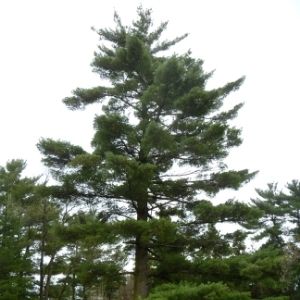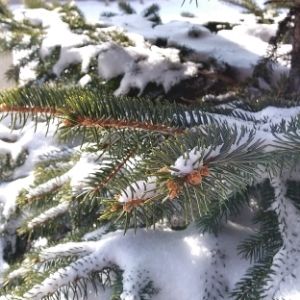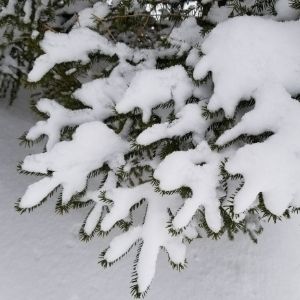What does evergreen mean? 
In order to understand the meaning of evergreen, it helps to break the word down. In a literal sense, evergreen means that a tree remains “green forever” (or as long as it is living). Foliage persists on evergreen trees throughout the year, unlike deciduous trees whose leaves change colour and drop according to seasonal environmental changes. The term evergreen can be deceiving as the colour on some evergreen species may not be green. For example, the foliage of the blue spruce (Picea pungens) tends to be more bluish in colour. Common types of evergreen trees growing in Ontario include spruces, pines, firs and cedars.

Both evergreen and deciduous trees use energy from the sun and nutrients and water from the ground in order to create food for survival. During the winter, however, sunlight and water become scarce, prompting trees to enter into a dormant or “sleeping” state. Because trees lose water through their leaves in a process called transpiration, deciduous trees in temperate areas (typically broadleaf trees, like maples or oaks) tend to drop their leaves in the winter in order to preserve water.
On the other hand, evergreen trees (which are typically trees with needles or scales, like spruces or cedars) will hold onto their foliage year-round because they are able to store enough water for survival throughout the winter. The design of needles and scales allows these trees to hold on to more water than their deciduous counterparts due to their smaller surface area and waxy coating.
Does evergreen and conifer mean the same thing?
The term evergreen refers directly to the foliage of a tree, whereas the term conifer means “cone bearing” and refers to the reproduction of a tree. It is important to note that these words are not synonymous with one another, although they are often mistaken as such. Furthermore, not all evergreens are conifers – but the majority of conifers are, in fact, evergreens. Some evergreens, such as boxwoods, do not produce cones. Alternatively, some cone-bearing trees, such as tamarack and cypress, are deciduous and will lose their foliage in the wintertime.

Planting evergreen trees on your property can provide you with a number of environmental and economic benefits. To begin, evergreen trees act as strong wind breaks. They can help reduce cold air entering indoors through crevices of window panes and door frames, particularly in older buildings and homes with more dated insulation. These trees can also help block snow from piling up near your home. This means that larger evergreen trees, such as the native white pine, white spruce or eastern white cedar, can actually help reduce your heating bills! Additionally, the dense foliage of native evergreens also provides excellent shelter for overwintering birds and other wildlife that are active throughout the cold season.
Interested in planting native evergreens (or deciduous trees) on your property? We can help! Check out our subsidized Backyard Tree Planting Program. We accept applicants year-round and are already processing applications for our spring planting and delivery season.
Adriana Rezai-Stevens is the Residential Planting Programs Field Coordinator at LEAF.
LEAF offers a subsidized Backyard Tree Planting Program for private property. The program is supported by the City of Toronto, the Regional Municipality of York, the City of Markham, the Town of Newmarket, the Town of Ajax, the Regional Municipality of Durham, the Township of Scugog, the City of Pickering, the City of Oshawa, the Town of Whitby and Ontario Power Generation.
